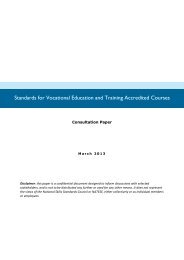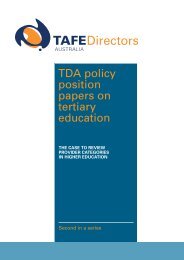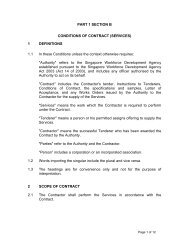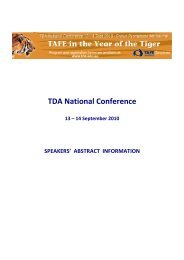Occasional Paper - TAFE Directors Australia
Occasional Paper - TAFE Directors Australia
Occasional Paper - TAFE Directors Australia
You also want an ePaper? Increase the reach of your titles
YUMPU automatically turns print PDFs into web optimized ePapers that Google loves.
30<br />
Tiger stripes:<br />
What should performance<br />
benchmarks look like<br />
DR TOM KARMEL<br />
Managing Director, National Centre for<br />
Vocational Education Research<br />
Dr Karmel took up the position of<br />
Managing Director, National Centre for<br />
Vocational Education Research (NCVER) in<br />
August 2002. Prior to this position he held<br />
senior appointments in the Federal<br />
government areas of education,<br />
employment, labour market research and<br />
the Bureau of Statistics. His research<br />
interests have centred on the labour market<br />
and the economics of education, focusing<br />
on empirical modelling, and he has a<br />
particular interest in performance indicators<br />
both in higher education and vocational<br />
education and training.<br />
He has an honours degree in mathematical<br />
statistics (Flinders University), a Master of<br />
Economics and a doctorate from the<br />
<strong>Australia</strong>n National University on the<br />
impact of increasing education levels on<br />
the <strong>Australia</strong>n workforce.<br />
Introduction<br />
The National Centre for Vocational Education<br />
Research (NCVER) has been interested in publishing<br />
institutional level statistics for some time, and<br />
a number of statistical publications have been<br />
released that provide data for individual providers<br />
but without names. This limits their usefulness<br />
because the whole point of individual provider data<br />
is so that readers can make comparisons across<br />
institutions. The reason for NCVER’s current approach<br />
is that the current Vocational Education and Training<br />
(VET) data protocols proscribe the publication of<br />
data for individual providers without the permission<br />
of the provider. This protocol has meant that, unlike<br />
for higher education where tables of indicators have<br />
been the norm for many years, there has been a<br />
complete absence of performance indicators for the<br />
VET sector.<br />
The Commonwealth government signalled in the<br />
2010 Budget that this situation is about to change,<br />
with funding provided for the development of the<br />
MySkills website for VET providers.<br />
Performance indicators need attention on three<br />
fronts. The first is the range of indicators that should<br />
be considered. The second is the unit of analysis -<br />
the provider as a whole or individual subject area.<br />
The third is the issue of statistical reliability.<br />
Likely indicators<br />
We need to distinguish between context and<br />
performance indicators. The former provide useful<br />
context to the reader so that he or she has some<br />
feeling for the type of institution being referred to.<br />
Obvious context indicators include:<br />
• Measures of size (number of students, full<br />
year training equivalents [FYTEs], number of<br />
campuses)
















